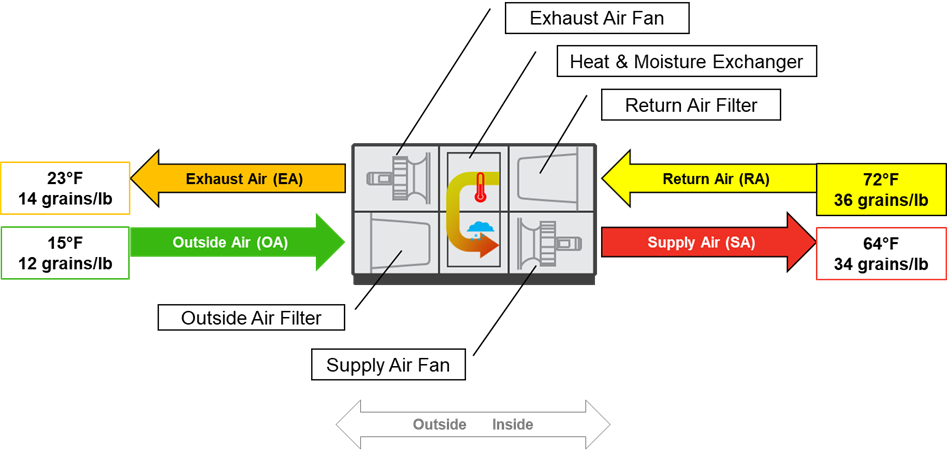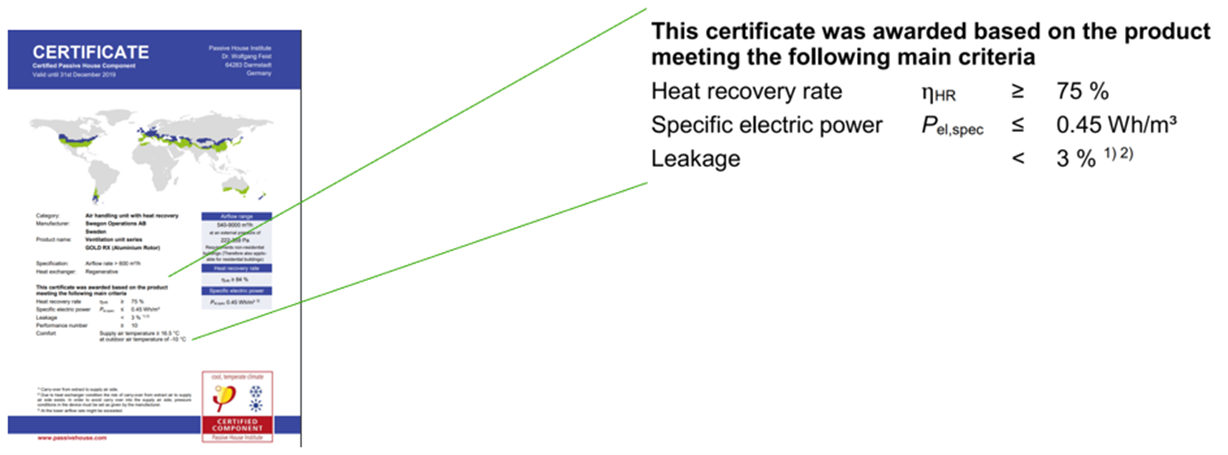Cover Photo: Carlington HUB, source: Photo credit to Krista Jahnke Photography. http://www.csv.ca/carlington-hub
Heat in air has two properties. Sensible Heat is the heat one would normally associate with the temperature measured by a thermometer. Latent Heat refers to moisture in the air. Both types of heat must be considered when selecting an appropriate air handling unit with heat recovery.
A Heat Recovery Ventilator, or HRV, is a type of air handling unit with a heat exchanger engineered to transfer just the sensible heat from the warm air stream to the cold air stream In winter, the heat exchanger moves heat from the warm exhaust air leaving the building to the cold outdoor air entering the building.
An Energy Recovery Ventilator, or ERV, is similarly a type of air handling unit with a heat exchanger engineered to transfer both sensible and latent heat. In addition to the sensible heat transfer also offered by an HRV, an ERV transfers latent heat from the more humid air stream to the drier air stream. In winter, this normally means moisture in the exhaust air stream is transferred to the relatively dry incoming outside air. from the warm moist exhaust air stream to the cold dry outdoor air as it enters the building.

An example of Heat Recovery Ventilator (HRV) winter performance is shown. To meet Passive House requirements, the HRV is operated under two conditions:
- the HRV provides continuous ventilation – the unit is on and ventilating during all occupied hours;
- balanced air flow – the Return Air (RA) volume equals the Supply Air (SA) volume.
In this example, the outdoor temperature is 15°F, and the building interior averages 72°F, as measured at the RA inlet of the HRV. The heat exchanger is approximately 85% effective, raising the Outdoor Air (OA) temperature and delivering the resulting SA to the building at 64°F. Depending on the goals of the specifier, post-heating and post-cooling coils may be added to the HRV to respectively raise or lower the SA temperature. There is no treatment of OA humidity – moisture entering the HRV is simply passed through to the building. In some climates, this is acceptable, since the OA moisture never requires dehumidification, although downstream terminal devices or coils could serve that purpose.
An example of Energy Recovery Ventilator (ERV) winter performance is shown in figure 2. The physical difference between the HRV in the previous example, and the ERV shown here is the addition of a hygroscopic coating to the heat exchanger, rendering it capable of transferring heat and moisture. This coating does not diminish the sensible heat transfer effectiveness. In this example, the OA dry-bulb temperature is 15°F and contains just 12 grains of moisture per pound of air. The building interior averages 72°F and contains 36 grains of moisture per pound of air, as measured at the RA inlet of the ERV. The heat exchanger is engineered to be a total energy recovery device, so that it is also effective transferring moisture from the airstream with the highest moisture content to the airstream with the lowest moisture content. With approximately 85% heat recovery effectiveness, the example ERV raises the OA temperature and moisture content, delivering the resulting SA to the building at 64°F with 34 grains of moisture per pound of air. This more than doubles the amount of moisture in the air entering the building. On the driest of winter days, this is an important health and comfort benefit to the occupants, while also reducing the cost of possible humidification.

In both examples, air is delivered to the building at 65°F, which may be suitable for providing occupant thermal comfort. If the specifier determines that additional post-heating of supply air is required, this may be accomplished by installing heating coils at the discharge of the air handling unit or installing heating coils in the occupied zone. The latter option may offer greater comfort control in some buildings.
Balance between energy saved and energy consumed
Both HRV and ERV are applied on Passive House and other building projects. Notable differences exist between procedures for HRV/ERV selection used for traditional buildings and for Passive House buildings. In a Passive House building, the HRV/ERV is expected to meet stringent performance requirements while balancing heat recovery with electrical consumption.
In the PHI certification program, only the Heat Recovery efficiency requires certification, that it exceeds the PHI threshold. Energy recovery efficiency may also be published but is not required by the terms of the PHI certification process. Likewise, an ERV may be applied on a Passive House project, but it is only the heat recovery efficiency component of the ERV performance that must meet Passive House requirements. The project may benefit from the moisture recovery provided by an ERV, however, there are no minimum latent recovery requirements.
A goal of a Passive House HRV is that Heat Recovery efficiency should meet a minimum threshold, but not at the expense of excessive electrical consumption. Electrical consumption must not exceed a maximum threshold, but consumption cannot be minimized at the expense of heat recovery efficiency. Furthermore, controls must be provided by the manufacturer that control the balance between Supply and Return Air volumes, to prevent loss of heat recovery efficiency and to prevent unnecessary infiltration and exfiltration due to under- or over-pressurization of the building. The selection process for an HRV/ERV for a Passive House is thus more involved than it is for a traditional code-compliant building.
LEARN MORE
Passive House Ventilation – Introduction
Swegon offers an AIA Nano Learning Course introducing the basic ventilation concepts that are important in Passive House design.
Certified heat recovery & electrical efficiency, leakage
A sample PHI certificate is shown in Figure 3. From the sample, we derive that for the specific manufacturer’s model and size, the unit meets the requirements for:
- Minimum heat recovery rate (75%)
- Maximum electrical consumption, expressed as specific electrical power (<0.765 W/CFM [0.45WH/m3])
- Maximum Leakage through the casing, and leakage from Return Air to Supply Air (<3%)

Figure 3 PHI certificate indicating threshold heat recovery, electrical consumption and leakage values for certification
Certified Air flow range
The PHI certificate also includes the HRV air flow range over which the certified efficiency values apply. Although an HRV might be capable of delivering air flow over a higher range of airflow, the certificate dictates the applicable airflow range. This range is related to the HRV test conditions, namely the external static pressure (ESP). A Passive House ventilation strategy calls for air distribution through a low-pressure duct system. This concept is encouraged by the test pressure limit imposed by PHI. HRV might be capable of delivering air against a higher ESP but doing so would nullify the certified efficiency values. In Figure 4, certified air flow parameters are shown as published on the PHI certificate. For Unit model 50, the PHI certificate only applies when the scheduled HRV air flow rates are between 5400 and 9000 m3/h (3178 and 5297 CFM) and at no more than 359 Pa (1.44 inWC) ESP.

Figure 4 PHI certificate indicating air flow parameters for certification
Determining the heat recovery efficiency
Code-compliant buildings have traditionally provided heat recovery values using the test methods governed by AHRI. AHRI and PHI have different goals concerning HRV testing. PHI states that as a rule, certified “components are two to three times more efficient than the corresponding commonly used products. This high level of efficiency is critical to achieving the Passive House Standard”. (See).
Furthermore, 2 significant differences exist between AHRI and PHI concerning the heat recovery efficiency.
- Heat Recovery Efficiency. The formula for AHRI heat recovery efficiency is different than the formula used by PHI. The AHRI formula adjusts the efficiency for airflow, while the PHI formula adjusts the efficiency for waste heat occurring within the HRV. Specifiers should include a definition of which program the HRV criteria are certified to for the purposes of the passive house project energy model. Read more.
- Minimum Efficiency. Both AHRI and PHI certify that a manufacturers selection data was verified in a third-party test lab. PHI has an additional minimum efficiency requirement of 75%. AHRI has no minimum heat recovery efficiency threshold.
Lowest First Cost v. lowest energy use
Passive House Institute certified HRV are selected based on the energy-saving concepts of Passive House Institute. The example in Figure 5 compares 2 ERV, both capable of delivering 3450 CFM of SA, both providing a heat recovery efficiency of ~85%. The smallest PHI-certified unit available to deliver 3450 CFM of ventilation air is a size 35, in order not to exceed PHI’s maximum electrical power of 0.77 W/CFM. By comparison, an AHRI-certified unit may be selected that is smaller and has a lower first cost, but it will consume 66% more power annually than the PHI-certified unit.
Traditionally, air handlers are selected based on constraints imposed by the design team:
- Minimize footprint to fit in available indoor space
- Minimize footprint to maximize use of solar panels on the roof
- Smallest unit that will work, with expected lowest first
- AHRI certification to provide third-party verification of manufacturers selection data. Adjustments are therefore required to the routine method of applying HRV. Larger Passive House HRV will have a bigger footprint, and higher first cost, but the economics of the Passive House concept justify the extra cost of the electricity saved during operation.

Is the larger unit worth the extra cost? If the energy savings is valuable to the project team, then yes. Sample energy consumption is shown, comparing the calculated annual energy consumption of 2 HRV: 1) a lowest-first-cost HRV and 2) an HRV meeting PHI criteria. At the specified air flow rate of 3450 CFM, the HRV selected to meet PHI criteria uses 41% less fan energy to deliver the same amount of air. When including the cost differences associated with recovery wheel motor operation, cooling, heating and moisture control, the PHI-certified HRV consumes roughly 10% less electricity than the lowest-first-cost HRV. Every project will have different results, and it is valuable to analyze the expected energy savings, including a full life-cycle cost analysis with every value engineering comparison.

When comparing options, consider the extra value of PHI-certification.
- Design phase. Passive House Planning Package (PHPP) is used to model building energy use and capture the Passive House energy performance. PHPP contains pre-loaded PHI-certified HRV performance, so that Passive House consultants simply select the HRV and the associated performance data is loaded into the model quickly and accurately.
- Verification phase. PHI certified projects using non-certified ERVs require field testing for as-built performance, followed by adjustment of the energy use summary in Passive House Planning Package (PHPP). Field testing of certifiable parameters is difficult and costly. PHI-certified HRV do not require field-verification of performance.
- PHIUS-certified Passive House projects. In the absence of its own ERV certification program, PHIUS accepts certified ERV data from PHI.
The Passive House building will benefit from the application of PHI-certified HRV. Evaluation of a PHI-certified HRV on any building project is also a worthwhile endeavor, any time energy savings is a primary goal.





.jpg?width=75&name=sigvardsson_220628_0008_small_webb%20(1).jpg)









